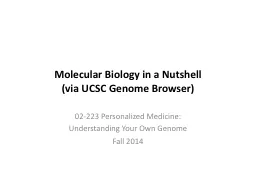

via UCSC Genome Browser 02223 Personalized Medicine Understanding Your Own Genome Fall 2014 DNA Doublestranded helix made up of the nucleotides A C G and T Sugar in its nucleotides is ID: 779266
Download The PPT/PDF document "Molecular Biology in a Nutshell" is the property of its rightful owner. Permission is granted to download and print the materials on this web site for personal, non-commercial use only, and to display it on your personal computer provided you do not modify the materials and that you retain all copyright notices contained in the materials. By downloading content from our website, you accept the terms of this agreement.
Slide1
Molecular Biology in a Nutshell (via UCSC Genome Browser)
02-223 Personalized Medicine:
Understanding Your Own Genome
Fall 2014
Slide2DNA
Double-stranded helix made up of the nucleotides A, C, G, and T
Sugar in its nucleotides is
deoxyriboseNucleotides form A–T and G–C base pairs across the helix
Slide3Central Dogma: How the Information in DNA is Expressed
DNA
(Sequence of A, T, C, G’s
)
(Sequence of A, U, C, G’s)
Gene
Transcription
Protein
(Sequence of amino acids
)
Translation
Nearly universal across all species!
Slide4Genes
In the recent human Encyclopedia of DNA elements (ENCODE) project
~20,000 protein-coding genes were studies, which covers 2.94% of the genome
Non-protein coding regions of the genome?>80% of the genome is functional as regulatory sequences, based on the analysis of ENCODE data
http://
www.nature.com
/encode/#/threads
Slide5RNA
RNA is similar to DNA, except that:
it is usually single-stranded
Sequence of A, U, C, Git has U in place of T, compared to DNAthe sugar in RNA nucleotides is ribose instead of deoxyribose
Protein-coding RNA: mRNA
Non-protein-coding RNA
Slide6Transcription
Transcription begins with
binding
by RNA polymerase at a promoter region of DNA.
The
s
subunit
is responsible for promoter recognition (in bacteria).
Once initiation has been completed with the synthesis of the first 8–9 nucleotides, sigma (
s) dissociates and elongation proceeds with the core enzyme.
Slide7Prokaryote vs Eukaryote Genomes
Eukaryotic mRNAs require processing to produce mature mRNAs.
Introns
(intervening sequences) are regions of the initial RNA transcript that are not expressed in the amino acid sequence of the protein.
Introns
are removed by splicing and the
exons
(
expressed) are joined together in the mature mRNA. The size of the mature mRNA is usually much smaller than that of the initial RNA.Prokaryote genomes do not have introns
Slide8Splicing out the Introns
Slide9Transcription in Eukaryotes: Introns and Exons
Slide10Transcription in Eukaryotes: Introns and Exons
Slide11Transcription Has Been Visualized by Electron Microscopy
Slide12Central Dogma
Slide13Central Dogma
RNA derived from complementary bases in DNA
In mRNA,
triplet
codons
specify 1 amino acid
Slide14Genetic Code for Translation
Genetic code is
degenerate
, with many amino acids specified by more than one codon.Only tryptophan
and
methionine
are encoded by a single
codon
.
The genetic code shows order in that chemically similar amino acids often share one or two middle bases in the triplets encoding them.
Slide15Initiator and Termination Codons
Termination
codons
: UAG, UAA, and UGA do not code for any amino acid.Initiator codon: AUG is the only codon
to encode for
methionine
.
Slide16Synonymous and Nonsynonymous Mutations
Synonymous mutations: mutations that does not cause the protein code to change
Nonsynonymous
mutations: mutations that cause the protein code to change
Slide17Summary
Central dogma
Transcription of DNA to mRNA
Translation of mRNA to proteinsIntrons/Exons in eukaryote genomes